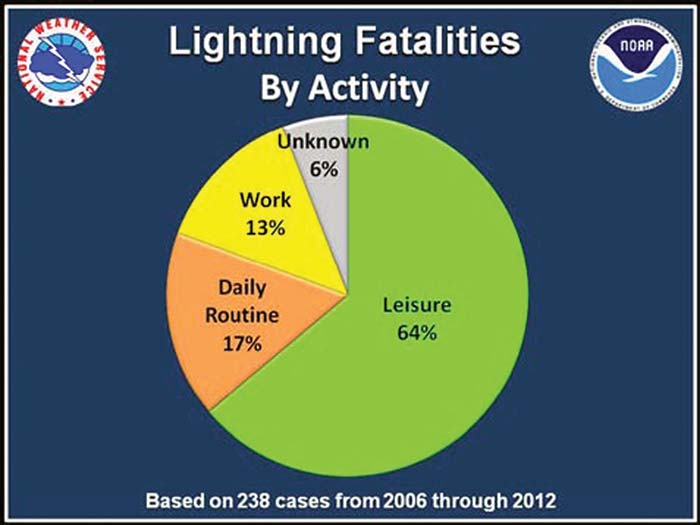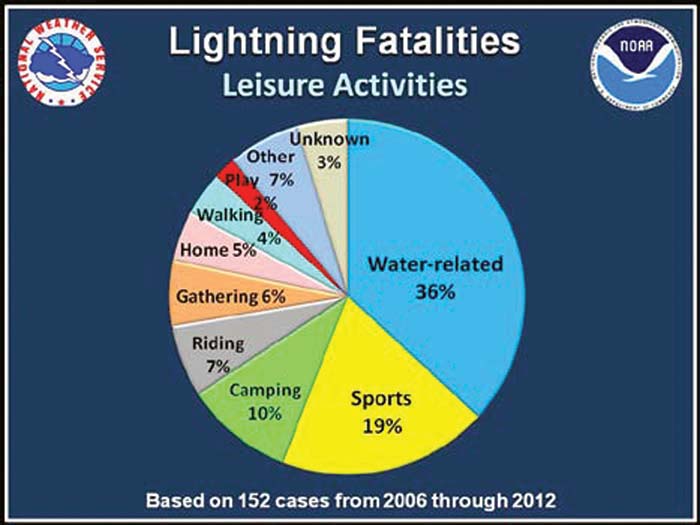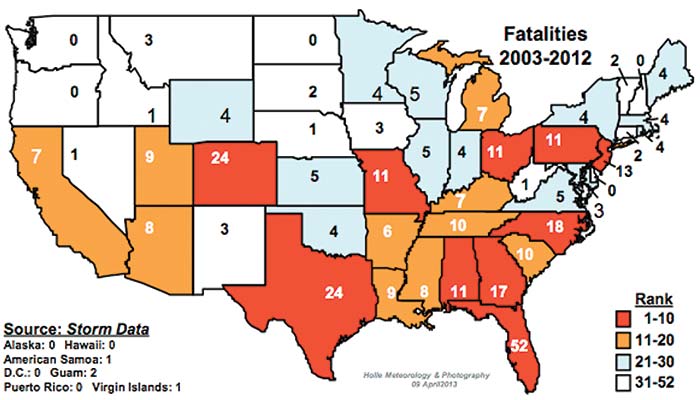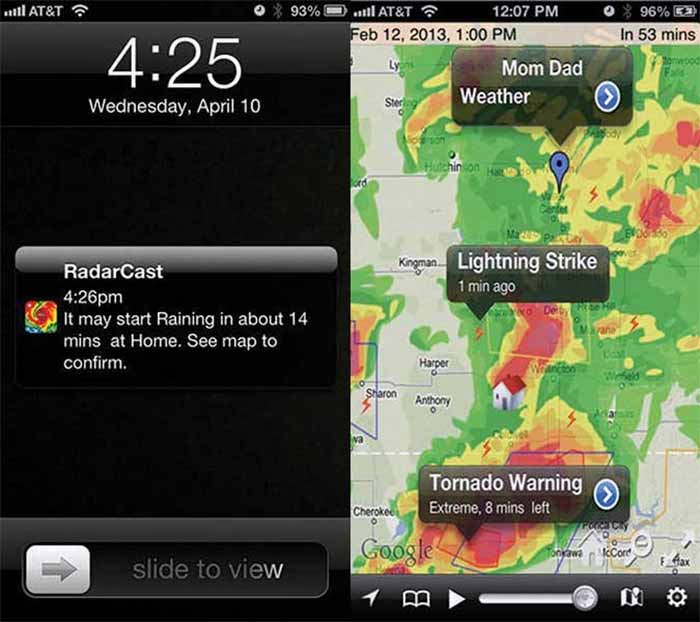Advertisement
Just how likely are you to be struck by lightning? If you're a boater in certain parts of the country, more likely than you might think.
Every time one of the megamillion lottery jackpots makes it into the news, several articles appear analyzing the odds and proving that you are far less likely to win the big bucks than you are to be struck by lightning. Those articles generally quote the risk of getting struck by lightning as 1 in a million, which sounds pretty comforting. But that's not all there is to the story.
As the chart below shows, your odds of being struck sometime in your lifetime, assuming you live to 80, are 1 in 10,000. Surprised? We were.
| Table 1. The Odds Of Getting Struck By Lightning | ||||
|---|---|---|---|---|
| Source: NOAA | ||||
| Estimated U.S. population as of 2011 | 310,000,000 | |||
| Annual number of deaths reported | 39 | Number of injuries reported | 241 | Total = 280 |
| Estimated number of deaths | 40 | Estimated number of injuries | 360 | Total = 400 |
| Odds of being struck by lightning in a given year (reported deaths + injuries) | 1/1,000,000 | |||
| Odds of being struck by lightning in a given year (estimated deaths + injuries) | 1/775,000 | |||
| Odds of being struck in your lifetime (Est. 80 years) | 1/10,000 | |||
| Odds you will be affected by someone being struck (10 affected/every 1 struck) | 1/1,000 | |||
Now, just to put this in perspective, 1 in 5 of us will die from heart disease. If you want to reduce your chances of an untimely death, you're far better off cutting back on donuts and hitting the treadmill than hiding under your bed during a thunderstorm. And lightning deaths have actually been declining since the middle of the last century, according to weather.gov/safety/lightning, peaking at 432 in 1943 and dropping steadily to a new low of 23 in 2013 (largely a function of work moving indoors). In fact, annual deaths and injuries have decreased by 40 percent since 2011, so based on that, the current odds of getting struck by lightning over the course of your lifetime might be more like 1 in 15,000. We're willing to bet that you're far more likely to die on your boat from a heart attack than from lightning.

Figure 1. Lightning Fatalities By Activity, 2006-2012 (Source: NSW, NOAA)

Figure 2. Lightning Fatalities By Leisure Activity, 2006-2012 (Source: NSW, NOAA)
That said, if you spend your leisure time out of doors, like we do, instead of playing video games, your odds of getting struck are, alas, higher than average. If you spend your outdoor time on the water, like we do, they are higher still. In fact, of the 238 lightning fatalities between 2006 and 2012, 40 of those, or 17 percent, occurred when the victim was fishing or boating. Only eight died playing golf.
If you boat in certain areas, you're even more likely to have a close encounter of the electrifying kind. That's because lightning strikes are far from evenly distributed across the country as Figure 3 shows. That translates into far more lightning deaths in Florida than any other state (Figure 4).

Figure 3. Cloud-to-Ground Lightning Incidence In The Continental U.S., 1997-2010 (Source: Vaisala Reprinted with Permission)

Figure 4. Lightning Fatalities By State, 1959-2012 (Source: Vaisala Reprinted with Permission)
So, if you boat or fish in Florida (and a few other high-risk states), your odds of being struck by lightning are clearly higher than average. How much higher? Still nowhere near dying of a heart attack, but high enough that it's not silly to think about. (If you boat on the West Coast, getting struck by lightning is silly to think about.)
OK, enough about you for the moment. How likely is your boat to be struck? The BoatUS Marine Insurance files suggest the incidence is somewhere around 1 in 1,000. And that's not lifetime risk — that's anytime risk. Most of us know someone whose boat has been hit. So your boat is much more at risk than you are. That's because it can't hide under the bed. Most boats can't even get in out of the storm. And, if it's miles from shore or has a big mast sticking out of it, it's very likely the tallest thing around. In a future issue, we'll talk about boats and lightning. But in the meantime, if we can make you safer, we'd like to. Until now, there's been no way to reduce your risk other than to get off the water at the first rumble of thunder. Very good advice, if not always a practical option. But today, technology can lend a hand.

Figure 5. Radar Cast Elite App
NOAA has made real-time lightning strike data available, and a number of app developers have integrated it into high-definition weather radar apps for both the iPhone and Android. Google "lightning app NOAA" and you'll find a selection. In addition to keeping you informed of storm activity and movement, these can give you a heads up when lightning is in your area, and allow you to see if it is moving toward you. If you are not too far offshore, they can provide adequate warning to get off the water and to safety before you even get wet.
So go online and get an app. It may not radically reduce the (already low) odds of your getting struck by lightning, but it's cool. And there is a very, very small chance that it will save your boat — or even your life — someday.
